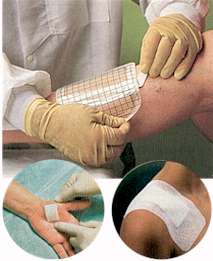Wounds-Content
From WikiEducator
Stages of Wound Healing:
Wounding :(Surgical, trauma, pressure, malignancy, vascular compromise etc.)
Contents
- 1 1.Hemostasis: Platelets secrete substances to cause vasoconstriction, factors which stimulate the production of thrombin, fibrin and fibrinogen and cytokines such as platelet-derived growth factor. Hemostasis is the shortest of the repair cycles and should occur within minutes of the injury (unless there are underlying clotting problems).
- 2 2.Inflammation phase: Second stage is represented by erythema, swelling, warmth and pain and last 1 to 4 days. The white blood cells are busy cleaning up the wound and preparing it for regeneration. Neutrophils and macrophages are the cells at work during this stage and the macrophages secrete growth factors in anticipation of stage three. Fibroblast growth factor, epidermal growth factor, transforming growth factor beta and interleukin-1 are the factors that prepare the site and steer the next stage of healing.
- 3 3.Proliferative phase: Granulation of new tissue begins in this stage and can take up to 21 days to complete. Cells in this stage are the fibroblast which facilitate wound contraction, pericytes which regenerate outer layers of capillaries, and endothelial cells which produce the lining. This process is called angiogenisis and is completed with keratinocytes which are responsible for epithelialization.
- 4 4.Remodeling: The last phase of tissue repair remodeling of the dermal tissue. The important cell in this phase is once again the fibroblast. This phase can take up to 2 years.
1.Hemostasis: Platelets secrete substances to cause vasoconstriction, factors which stimulate the production of thrombin, fibrin and fibrinogen and cytokines such as platelet-derived growth factor. Hemostasis is the shortest of the repair cycles and should occur within minutes of the injury (unless there are underlying clotting problems).
2.Inflammation phase: Second stage is represented by erythema, swelling, warmth and pain and last 1 to 4 days. The white blood cells are busy cleaning up the wound and preparing it for regeneration. Neutrophils and macrophages are the cells at work during this stage and the macrophages secrete growth factors in anticipation of stage three. Fibroblast growth factor, epidermal growth factor, transforming growth factor beta and interleukin-1 are the factors that prepare the site and steer the next stage of healing.
3.Proliferative phase: Granulation of new tissue begins in this stage and can take up to 21 days to complete. Cells in this stage are the fibroblast which facilitate wound contraction, pericytes which regenerate outer layers of capillaries, and endothelial cells which produce the lining. This process is called angiogenisis and is completed with keratinocytes which are responsible for epithelialization.
4.Remodeling: The last phase of tissue repair remodeling of the dermal tissue. The important cell in this phase is once again the fibroblast. This phase can take up to 2 years.
If at any time during this process the wound is compromised or the “whole person” is not healthy the healing stops and complications occur.
